
Napier is a city on the eastern coast of the North Island of New Zealand and the seat of the Hawke's Bay region. It is a beachside city with a seaport, known for its sunny climate, esplanade lined with Norfolk Pines and extensive Art Deco architecture. Napier is sometimes referred to as the "Nice of the Pacific", although that is largely outdated and a more common nick-name is 'The Art Deco Capital of the world'.

The 1931 Hawke's Bay earthquake, also known as the Napier earthquake, occurred in New Zealand at 10:47 am on 3 February, killing 256, injuring thousands and devastating the Hawke's Bay region. It remains New Zealand's deadliest natural disaster. Centred 15 km north of Napier, it lasted for two and a half minutes and had a magnitude of 7.8 (7.7 ). There were 525 aftershocks recorded in the following two weeks, with 597 being recorded by the end of February. The main shock could be felt in much of New Zealand, with reliable reports coming in from as far south as Timaru, on the east coast of the South Island.
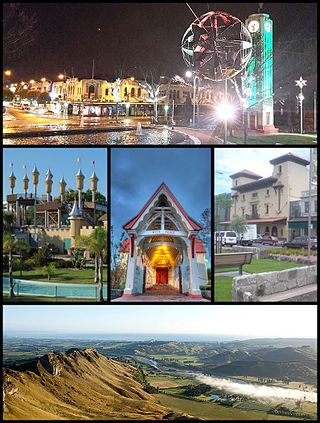
Hastings is an inland city of New Zealand and is one of the two major urban areas in Hawke's Bay, on the east coast of the North Island. The population of Hastings is 50,400, with a further 15,100 people in Havelock North and 2,470 in Clive. Hastings is about 18 kilometres inland of the coastal city of Napier. These two neighbouring cities are often called "The Bay Cities" or "The Twin Cities".

Territorial authorities are the second tier of local government in New Zealand, below regional councils. There are 67 territorial authorities: 13 city councils, 53 district councils and the Chatham Islands Council. District councils serve a combination of rural and urban communities, while city councils administer the larger urban areas. Five territorial authorities also perform the functions of a regional council and thus are unitary authorities. The Chatham Islands Council is a sui generis territorial authority that is similar to a unitary authority.
Waipukurau is the largest town in the Central Hawke's Bay District on the east coast of the North Island of New Zealand. It is located on the banks of the Tukituki River, 7 kilometres south of Waipawa and 50 kilometres southwest of Hastings.

Takapau is a small rural community in the Central Hawkes Bay in New Zealand. It is located 20 kilometres west of Waipukurau, off State Highway 2, and has a population of more than 500.
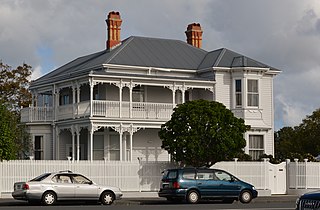
Herne Bay is an affluent suburb of Auckland, New Zealand. It is located on the southwestern shore of the Waitematā Harbour to the west of the Auckland Harbour Bridge. It is known for its extensive harbour views, marine villas and Edwardian age homes. Herne Bay has been a prosperous area since the 1850s due to its outlook over the Waitemata Harbour. It continues to be an exclusive suburb, as it ranked as the most expensive suburb in New Zealand in 2015. In 2021 it again topped rankings of the most expensive suburbs in New Zealand, with a median property value of $3.25 million.
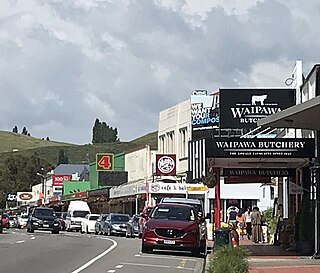
Waipawa is the second-largest town in Central Hawke's Bay in the east of the North Island of New Zealand. It has a population of 2,400.

Westmere is a residential suburb of Auckland, in northern New Zealand. The Auckland Council provides local governance. On the southern shore of the Waitematā Harbour, this former peninsula is by road about 6 kilometres (4 mi) west of the city centre.

The Walsh Brothers Flying Boats were aircraft that were used during World War I to provide training to pilots in New Zealand prior to their enlistment into the Royal Flying Corps.

The New Zealand Flying School was formed in 1915, by the Walsh Brothers, Leo and Vivian, to train pilots for the Royal Flying Corps. The school flew a fleet of home-built and imported flying boats from Mission Bay on Auckland's Waitemata Harbour, near where a sculpture now stands to commemorate the Walsh brothers. Over 100 pilots trained at the school, most of them going on to serve in the First World War, including ace Keith Caldwell.
The Scout Association of New Zealand's Sea Scouts are Scout Groups specialising in water-based activities. In 2017, there were around 900 Sea Scouts in New Zealand in 53 troops around the country.

The Seaside Museum Herne Bay is a local museum in Herne Bay, Kent, England. It was established in 1932 and is notable for being a seaside tourist attraction featuring local archaeological and social history, for featuring the history of the town as a tourist resort, for its local art exhibitions, and for its World War II bouncing bomb. The management of the Museum was awarded by Canterbury City Council to the Herne Bay Museum Trust, who reopened it in July 2015 as The Seaside Museum Herne Bay.

Evans Bay is a large bay at the southern end of Wellington Harbour, New Zealand. Located between the Miramar Peninsula and Hataitai, it was the site of New Zealand's first patent slip and served as Wellington's international flying-boat terminal from 1938 until 1956. It is named after George Samuel Evans, an early Wellington settler.

Coxs Bay or Opoututeka is a bay located in the Waitematā Harbour in the Auckland region of New Zealand. It lies between the settlements of Westmere and Herne Bay to the southwest and northeast respectively, and to the southeast is Grey Lynn. The Bay is protected from the west by the end of one of the longest lava flows in the Auckland volcanic field, Te Tokoroa / Meola Reef.
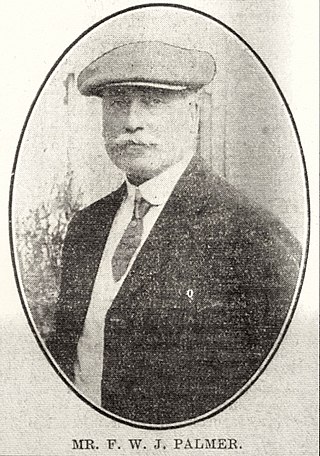
Frederick William J. Palmer, CE, (1864–1947), known professionally as F. W. J. Palmer, was an English civil engineer, structural engineer and surveyor. From 1891 he was Surveyor to Herne Bay Urban District Council. As Town Surveyor between at least 1891 and 1915 he was responsible for arranging the digging up of a great deal of Herne Bay. He organised the reconstruction of all the main roads, saw to the rebuilding of the council offices and Hampton Pier and led the construction of a new sea wall. He led the Sewerage of the East Cliff and nine miles of private roads at the east end of Herne Bay. He designed both phases of the King's Hall, Herne Bay. His works helped to provide employment and to make the town what it is today. Archaeological artefacts turned up by his constant digging contributed to the collection now in Herne Bay Museum.
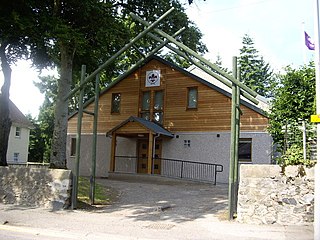
A Scout hall is a building owned or rented and used as a meeting place by a Scout Group.
Napier City Council is the territorial authority of Napier, Hawke's Bay Region, New Zealand.

Rissington is a farming settlement 15 km (9.3 mi) north west of Napier, New Zealand. It lies in Hawke's Bay Region, between Sherenden and Napier, in the Mangaone River valley, on the road to Patoka and Puketitiri. A fire station, cemetery and a war memorial are the only remaining public structures, but it once had several more and was home to the country's first Women's Institute, co-founded by Amy Hutchinson and Bessie Spencer.

New Zealand performing arts venues are places in New Zealand that are set up to host performing arts and music events such as theatre, dance and concerts.


















